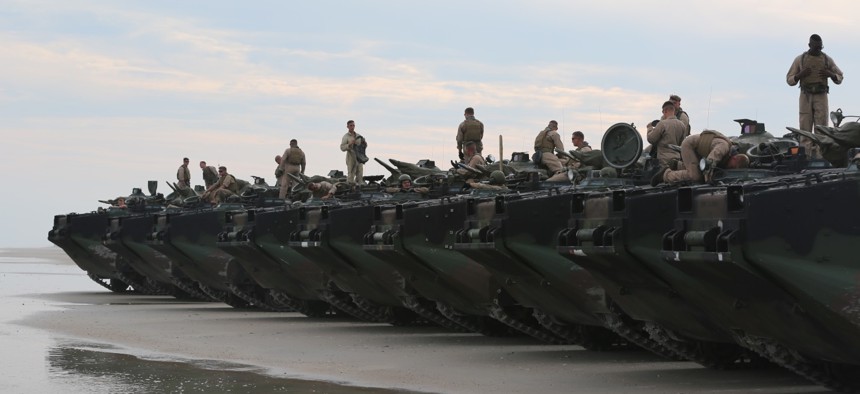
Marines with the 2nd Assault Amphibian Battalion wait for the final check of their amphibious assault vehicles during a 2015 exercise at Camp Lejeune N.C. Lance Cpl. Miranda Faughn / II Marine Expeditionary Force
The Physical Obstacles to the Pentagon’s Connect-Everything Vision
Jets, destroyers, and soldiers are very different data customers, but the Pentagon wants to serve them all equally.
Several obstacles stand before the Pentagon's connect-everything vision, and simply linking computers and networks won’t solve them.
On Monday, Raytheon announced that it will help build out a key portion of the Advanced Battle Management System, or ABMS—the Air Force's contribution to the Defense Department's effort to connect all of the military's air, space, sea and land assets. It will join eight other contractors helping to create the Air Force's Common Tactical Edge Network, which “will provide edge networking to help operators enable distributable battle management command and control in highly contested environments to support Joint All-Domain Command and Control,” or JADC2, Raytheon said in a statement.
In November, Raytheon executives told reporters that “RIPL” experiments they were doing with the Air Force Research Lab are developing ways to give users access to information in contested environments by using artificial intelligence to determine what information is most critical and the best time and method for delivering it.
The executives also highlighted their work in high-frequency communications for command and control.
“From that standpoint, we've got about 500 terminals around the world today with the U.S. Army and the Navy and the Air Force. And we're looking to see if we can extend that capability and allow us to think about how do we integrate that with a joint all domain [command and control] environment to think about information flow and extend the capabilities of the system so you can get information at the edge in a very secure manner,” said Paul Mongillo, Raytheon’s vice president of requirements and capabilities, communications, and airspace management.
The execs also described how Raytheon is trying to condense business areas to get ahead of where they think the Defense Department is going.
“In the beginning [of] this year, [Raytheon Intelligence and Space] had a communications business. They had an [electro-optical/infrared] business, a fire control business and an [electronic warfare] business. They look[ed] at the market growing together because of the use of aperture with algorithms and techniques behind it,” and began to combine those business areas into one another, said Paul Meyer, an exec at Raytheon Intelligence & Space.
Some experiments, like RIPL, are beginning to show promise, and established defense industry players are aligned with the JADC2 vision. But there are still big obstacles in the way of seamless battlefield networking across all the services and all the domains—especially in contested environments. The biggest challenge: The Air Force, Army, Navy, and Space Force all have very different communications needs. It’s one of the reasons that in the early days of JADC2, the Army and Air Force seemed to be at odds over who would lead the effort.
Service leaders are now much more aligned on the path forward, but the differences in information needs remain.. And those needs are sometimes determined by physical factors, such as the amount of room onboard ships or jets for communication equipment.
At the November event, Dave Deptula, a retired Air Force three-star and current dean of the Mitchell Institute of Aerospace Power Studies, said he thinks “one of the challenges is that the defense enterprise writ large has to come up with an architecture that can be understood, and that drives each of the services efforts to achieving this goal.”
Meyer went into a bit more detail. “It's clear the Army thinks that they have a different problem because they have to get [information] down there to individual soldiers. So it's a different scale problem.” And the Army’s scale problem is significantly different than what the Air Force and Navy are facing, since they have far fewer entities to connect together into a single network. The Air Force and Navy may also use similar data lakes and some of the same data structuring practices. “They're more homogeneous I would say than the Army,” Meyer said. “It's because the Army has got this maneuver [concept of operations] that has to serve tens of thousands of soldiers, and they want them all to be connected.”
But more importantly, the physical means for downloading and uploading information will also differ across services and even across environments.
“A Navy ship only has so many places” that work for large antennas, Meyer said. “They’re worried about radiation and people if you're standing out there in front of it. But there's only so much space on an aircraft carrier. I mean, you think it looks big, but, you know, when you look at what they do on the superstructure right now, as a mass, there's still limitations and they've got electromagnetic interference. So they've got a problem, whether it’s destroyers or the aircraft carriers.”
On planes, the problem is different because of the limited space for computer hardware. And for the Army, they have“ wheels or tracks on the move and they’ve got to live in dirt and reliability in that environment has a severe impact on what they can or cannot do,” he said.
Figuring out how to meet not only the data needs of each of those services—under all possible conditions—will take more than simple software engineering. It’s something that the Defense Department is still trying to figure out.




